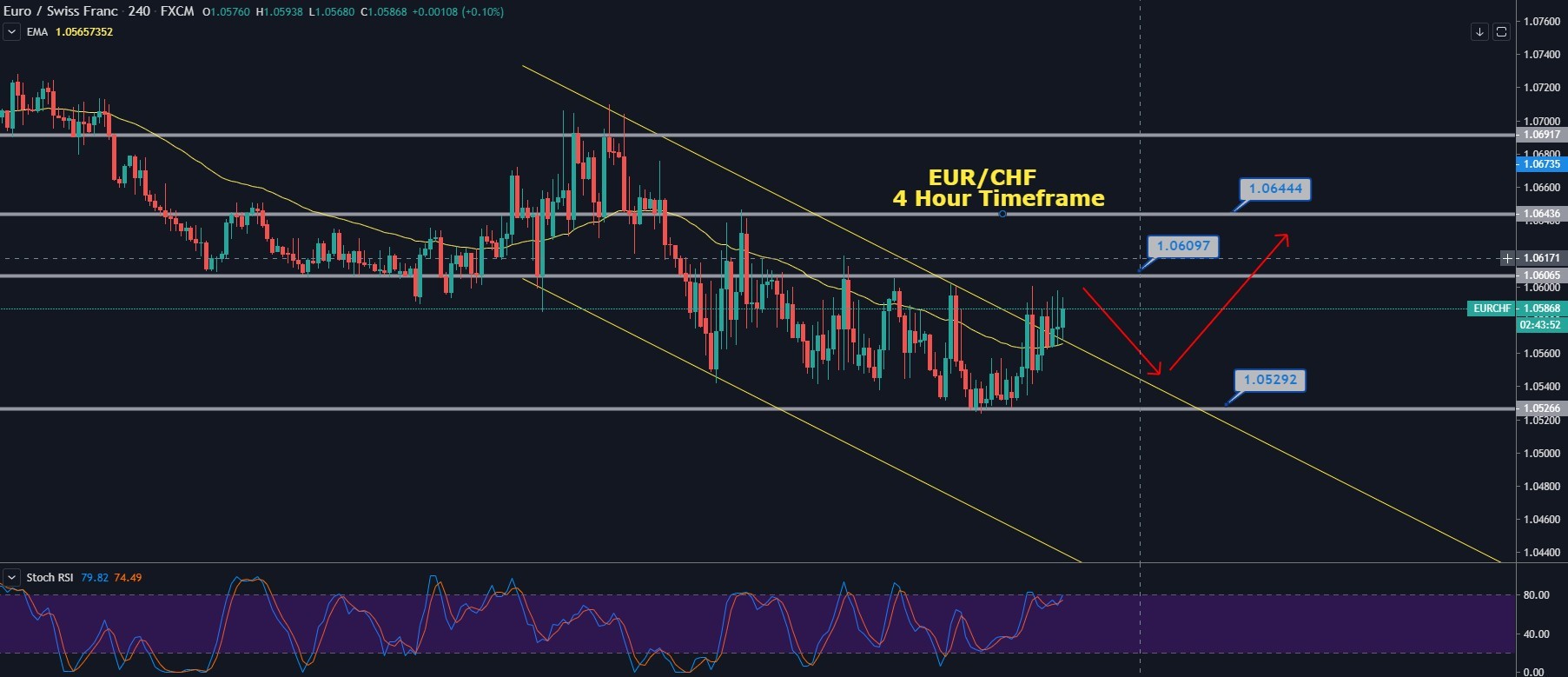The EUR/CHF is trading at 1.0589, having violated the downward channel at 1.0560. Currently, the pair is holding outside the downward channel, and technically, this should drive buying in the EUR/CHF pair, but the pair is facing an immediate resistance around 1.0609. This particular resistance is extended by triple top pattern, and violation of this can open up further room for buying until 1.0609.
One of the reasons behind a bullish trend in the EUR/CHF is a stronger Euro in the wake of business activity in Germany, which fell sharply in March. Still, the figures were not as bad as economists anticipated.
The headline Flash Germany Composite PMI Output Index dived from 50.7 in the month of February to 37.2, its lowest since February 2009. The preliminary figures were based on replies settled between March 12-23.
The dramatic dip in activity in March was prompted by the service area, where companies highlighted the influence of efforts to contain the spread of the coronavirus disease 2019 (COVID-19).
The EURCHF is consolidating in a narrow trading range of 1.06010 - 1.0520. The pair is trading at 1.0540 after having violated the horizontal support level of 1.0550, which has exposed additional room for selling in the EUR/CHF pair.
For now, the same 1.0550 level is going to work as resistance and violation of which may extend buying until 1.0575. While below EURCHF may head for the next target level of 1.0380 in case of bearish breakout of 1.0510.
EUR/CHF - Trade Signal
Buy Above 1.0569
Take Profit 1.0634
Stop Loss 1.0536
Risk Warning: CFD and Spot Forex trading both come with a high degree of risk. You must be prepared to sustain a total loss of any funds deposited with us, as well as any additional losses, charges, or other costs we incur in recovering any payment from you. Given the possibility of losing more than your entire investment, speculation in certain investments should only be conducted with risk capital funds that if lost will not significantly affect your personal or institution’s financial well-being. Before deciding to trade the products offered by us, you should carefully consider your objectives, financial situation, needs and level of experience. You should also be aware of all the risks associated with trading on margin.
Recommended Content
Editors’ Picks
AUD/USD jumps above 0.6500 after hot Australian CPI data

AUD/USD extended gains and recaptured 0.6500 in Asian trading, following the release of hotter-than-expected Australian inflation data. The Australian CPI rose 1% in QoQ in Q1 against 0.8% forecast, providing extra legs to the Australian Dollar upside.
USD/JPY hangs near 34-year high at 154.88 as intervention risks loom

USD/JPY is sitting at a multi-decade high of 154.88 reached on Tuesday. Traders refrain from placing fresh bets on the pair as Japan's FX intervention risks loom. Broad US Dollar weakness also caps the upside in the major. US Durable Goods data are next on tap.
Gold price cautious despite weaker US Dollar and falling US yields

Gold retreats modestly after failing to sustain gains despite fall in US Treasury yields, weaker US Dollar. XAU/USD struggles to capitalize following release of weaker-than-expected S&P Global PMIs, fueling speculation about potential Fed rate cuts.
Crypto community reacts as BRICS considers launching stablecoin for international trade settlement

BRICS is intensifying efforts to reduce its reliance on the US dollar after plans for its stablecoin effort surfaced online on Tuesday. Most people expect the stablecoin to be backed by gold, considering BRICS nations have been accumulating large holdings of the commodity.
US versus the Eurozone: Inflation divergence causes monetary desynchronization

Historically there is a very close correlation between changes in US Treasury yields and German Bund yields. This is relevant at the current juncture, considering that the recent hawkish twist in the tone of the Fed might continue to push US long-term interest rates higher and put upward pressure on bond yields in the Eurozone.
